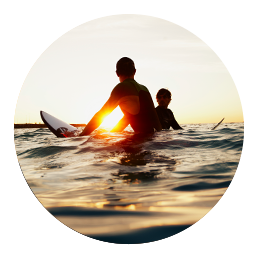 Shark activity map
Shark activity map
Switch on your Sea Sense.
Read more
Latest shark advice and warnings.
Read More










Staying Safe
The Western Australian Government is committed to keeping the community as safe as possible when using our oceans. There is no one simple solution, shark encounters are rare and the following shark safety initiatives, operational responses and shark safety tips, allow the community to keep informed and help reduce the risk of a shark encounter.
Beach and Aerial Surveillance
29 September 2016The Western Australian Government will provide Surf Life Saving WA (SLSWA) with $4 million for the delivery of shark mitigation strategies over 2024/25. Funding is used for aerial patrols provided by SLSWA’s Westpac Life Saver Rescue Helicopter, beach patrols, coordination of service and emergency responses via SurfCom communications centre and a jetski response team.
Surf lifesavers are watching from the beaches, on the water and in the air and public officers are ready to respond to sightings. Swimming between the flags at patrolled beaches means that if a shark is sighted, the information will be communicated quickly to the front line responders and the beach can be closed by lifesavers.
SLSWA has statewide standard operating procedures for shark sightings, including guidelines on when to clear the water and close a beach, and how long a beach should remain closed.
When swimming at an unpatrolled beach, please remember that Rangers are not always close-by to respond quickly to a shark sighting (particularly in regional areas). So it’s important water users take responsibility for their own safety and check the latest reported sighting and tagged shark detection information on the shark activity map or by downloading the SharkSmart WA app, and follow our common sense tips.
The Western Australian Government provides funding to SLSWA to operate two lifesaving helicopter services, the metropolitan based Westpac Life Saver Helicopter and the South West Life Saver Helicopter.
- The metropolitan service, based at Rous Head North Fremantle, patrols between Mandurah and Yanchep, and Rottnest Island to the west. Patrols are scheduled on weekends throughout September and daily from 21 September 2024 to 30 April 2025.
- South West flights will also run daily throughout school holidays and peak periods (21 September to 6 October 2024, 16 November 2024 to 4 February 2025, 12 to 27 April 2025). At all other times between September 2024 and 30 April 2025, the South West helicopter will fly on weekends and public holidays. The service patrols between Bunbury and Hamelin Bay.
The helicopter service provides many benefits including the ability to directly communicate with the public. When a shark is sighted, the helicopter will hover and sound its siren to warn beach users that there is a shark in close proximity. In addition, the crew are medically trained and equipped to assist in a real time emergency when needed.
Details on SLSWA patrolled beaches can be found on the SharkSmart WA app and on SLSWA My Beach website.
To improve beach surveillance, the Western Australian Government has previously funded:
- 12 new jet skis to SLSWA, providing an additional tool to boost public safety at beaches.
- Two new life guard stations at Cottesloe Beach providing a vantage point to look out for sharks and other safety hazards such as rips. Similar stations have also been erected at North Cottesloe Beach, funded by the Town of Cottesloe and at City Beach, funded by SLSWA.
- A trial of drone patrols to monitor beaches at a number of metropolitan and regional locations.